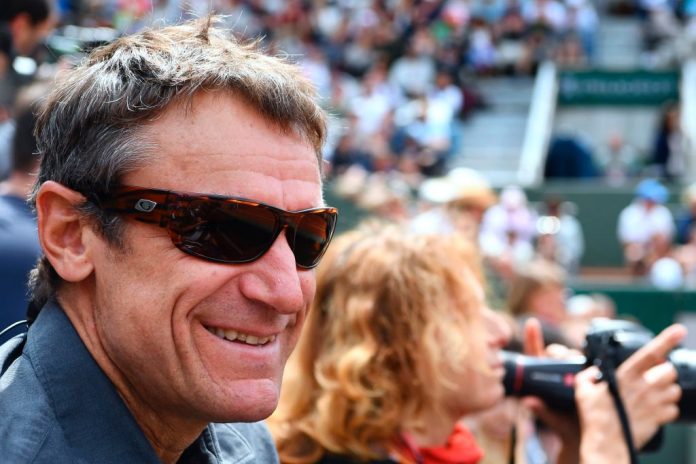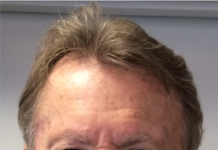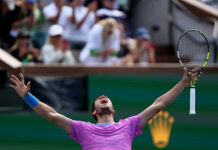FRENCH OPEN – A HIGH POINT
By Michael Mewshaw
In the lull after Serena Williams withdrew injured from Roland Garros, the tournament seemed to subside not just to a halt, but to a miserable low point in the absence of a lively, combative quarterfinal between Serena and Maria Sharapova. But then as fate would have it, I got the opportunity to revisit one of the highest points, the most beautiful moments, in the history of the French Open. Mats Wilander wandered into the Press cafeteria on Stade Philippe Chatrier and I asked him to share his memories of his 1982 semi-final victory over the Argentinian ace José Luis Clerc, the famous occasion when Wilander, then a curly-haired seventeen-year old Swede, gave away a match point. The umpire, Jacques Dorfmann, had already called game, set and match in Wilander’s favor and climbed down from his chair when Mats said the ball had been good. He refused to accept the win and insisted the point be replayed. Grateful, but shell-shocked, Clerc served again to stay in the match and lost a second time, unleashing pandemonium.
Clerc refused to appear for his post-match interview and fled the tournament site. In extraordinary circumstances chair umpire Dorfmann agreed to speak to reporters and declared with Gallic wisdom, “the situation was paradoxical.” While he admitted that the replayed match point had not respected the letter of the law, it had, he believed, lived up to the spirit of sportsmanship. Never in all his career had he witnessed such a gesture of fair play, especially not on match point in the semi-finals of a Grand Slam.
Of course, Mats Wilander hadn’t forgotten a moment of that day 36 years ago. At the age of 53, his hair is cut short and his face prematurely lined after years in the sun. He doesn’t look like he has gained a pound since his retirement. If anything he’s slimmer. When not commentating on TV, he wears dark horn-rimmed glasses that give him a slightly professorial appearance. He speaks a bit like a professor, too, with brainy thoughtfulness and shrewd observations about the game.
“I didn’t give up that match point to be nice,” Mats said. “I did it because the ball was in. It was actually a selfish thing to do. I didn’t want to win in the wrong way. I wanted to be right. A lot of other guys back then and now would do the same.”
I disagreed. Most men would have played the umpire’s call and taken the match. And that’s why his gesture had won him the Pierre de Coubertin World Fair Play Trophy.
Still, Mats maintained that he had had less generous motives for behaving like a hacker playing a friend in the park, chirping, “By all means, take two.”
“What I did,” Wilander explained, “was as much about confidence as fair play. I thought I had figured out Clerc’s game and would beat him anyway.” To my surprise he slapped his arm at the elbow in the “up yours” sign.
“Then, too,” he added, “I was seventeen and knew I’d be in the locker room for many years to come.” He hadn’t wanted to make an enemy of Clerc or let him and other players complain that he had had to cut corners to win. After all, he had already beaten Lendl and Gerulaitis to reach the semi-finals.
Yet he conceded that he had gone on into the 1982 final against Guillermo Vilas with no great conviction he’d win. “Vilas had just beaten me in straight sets in Madrid. I was just focusing on winning games. I got one in the first set. Then we stayed even in the second and I won it in a tie-break. Suddenly I could see that I was stronger and believed I could beat Vilas.”
Indeed, he did just that, winning the third set 6-0 and the fourth set 6-4, in a war of attrition that lasted four hours and forty-two minutes.
With self-deprecating humor, Wilander often called his style boring. But as he breaks it down, it’s clear that he was then and is now fascinated by the problem-solving challenges of tennis. He proceeded to discuss his loss to Yannick Noah in the 1983 French Open and observed, “That match taught me more than any other. I learned that I had to develop a slice backhand and come to the net when I had the chance. This helped me win on other surfaces, like the grass in Australia and the hard courts at the US Open.”
Still, he never entirely abandoned his baseline style. “You can be aggressive from the baseline,” Mats said. “Just look at Rafa.”
This led to the obvious question: How would Wilander cope with the best clay-courter of all time?
“I asked Pete Sampras the same thing,” Mats said.
“How would you play Rafa? And Pete told me he’d never wait more than two shots to rush the net.” Mats laughed. “Pete admitted he’d lose but would do it on his terms, not Rafa’s.”
And you, I pressed him. How would you play Rafa?
“I’d disrupt his game. I wouldn’t let him find his rhythm. A lot of guys are embarrassed to try something different. They’d just as soon hit for the lines and get off the court as quick as they can.”
The implication was clear – Wilander would stay on court as long as he could. Also unsaid was the truth that the odds would be against Mats Wilander, but no more than they had been in 1982 when as an unseeded boy fresh out of the juniors he had outthought and outlasted four of the five best players in the world to win the first of his seven Grand Slam titles.
Michael Mewshaw is the author of 21 books. His collection of tennis essays, Ad In, Ad Out, is available as an e-book.



















